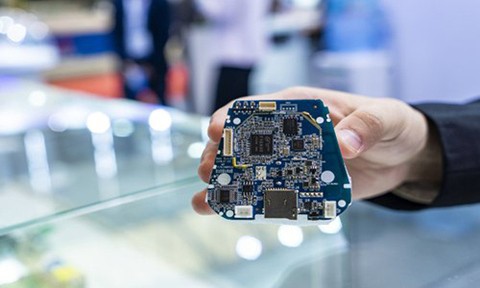Semiconductors a key industry that VN is aiming for in the future
The scale of this market is about more than US$600 billion last year, and is forecasted to reach $1.4 trillion by 2029.
Recently, leading US businesses and corporations in the field of semiconductors assessed that Việt Nam has potential and opportunities to develop the semiconductor industry ecosystem. — VNA/VNS Photo
To maintain a high growth rate of exports, it was necessary to target new trends, including semiconductors, said experts.
The scale of this market reached more than US$600 billion last year, and is forecasted to reach $1.4 trillion by 2029.
Việt Nam is a very open economy, with total import-export turnover reaching 200 per cent of GDP, making the economy vulnerable to external fluctuations, said experts.
Economic expert Nguyễn Đình Cung, former director of the Central Institute for Economic Management (CIEM) told Doanh Nhân Việt Nam (Vietnamese Businessman) online magazine that Việt Nam's economy was very open and was becoming more and more open. Therefore, the economy was susceptible to even external factors.
Finding a solution to this problem, experts say that to avoid external injuries, Việt Nam needs to change soon.
Pointing out the weakness of the Vietnamese economy, Cung said there were three important components including the FDI enterprise sector, the private sector and the State-owned enterprise sector.
However, these sectors had not been closely linked and unified with each other, said Cung.
To enhance the economy's resilience to external factors, these components needed to be more closely linked, he said.
When exports tended to weaken, they need support from the domestic market and vice versa, he added.
Cung predicted that the economy would continue to have an important driving force from the FDI and export sectors in the future, but for sustainable development, fundamental changes were needed.
Cutting rely on the cheap advantage
First, to attract FDI and improve export growth, we must not continue to rely on the advantage of low prices, said experts.
Major countries were currently tending to change their thinking and strengthen their foundations, said Cung.
These countries are increasing their self-reliance in controlling the supply chain by moving factories to their home country or closer countries, which has caused a significant impact on the supply chain.
The good news was that Việt Nam's position was increasingly growing as it had become an important partner of many large countries, said experts.
Việt Nam has also just upgraded its relationship with the US to the level of a comprehensive strategic partnership.
This event has opened up many opportunities for Việt Nam, especially in attracting investment in fields with high technology content and high added value such as the semiconductor industry.
Recently, leading US businesses and corporations in the field of semiconductors also assessed that Việt Nam has many potentials and opportunities to develop the semiconductor industry ecosystem.
These businesses also said they were studying the possibility of locating chip factories in Việt Nam.
At the recent visit of US President Joe Biden, many large US semiconductor businesses such as Intel, Amkor, Marvell, and GlobalFoundries signed a commitment to invest in Việt Nam. They assess that high-quality human resources and the improving capacity of businesses and training facilities in Việt Nam are the necessary factors, not cheap human resources.
It can be seen that the trend of competing with cheap human resources has passed. Previously, Việt Nam's initial investment and export activities were mostly in low value-added sectors such as textiles, garments and footwear.
After that, the country has quickly moved up the value chain, developing into an important electronics assembly centre thanks to the investment participation of a number of technology "giants".
Typically, Samsung, up to now, its investment has reached $18 billion, accounting for about one-quarter of Việt Nam's export value.
This has also encouraged other tech giants, especially Apple, to expand their operations.
However, experts assessed that to maintain export momentum, it was necessary to attract and develop fields with high technology content such as the semiconductor industry because this was the leading trend in the future.
Many semiconductor "giants" heading to VN
The scale of the global chip market was about more than $600 billion last year, and it was forecasted that it would reach 1,400 billion by 2029, an opportunity for for Việt Nam in this huge giant cake, said Nguyễn Mại, Chairman of the Việt Nam Association of Foreign Invested Enterprises (VAFIE).
Semiconductor technology is a 'story of the whole world', developed countries were giving incentives to expand research and production for this industry, said Mại.
Việt Nam did not have much money to invest, so it had to rely on FDI capital attraction for development, he added.
Samsung and Intel are two electronics giants and also leading enterprises in the semiconductor industry.
Intel has increased the investment capital of this project to nearly $1.5 billion in 2021, and is planning to invest more to expand the factory in Việt Nam.
Samsung also announced plans to produce semiconductor components in Việt Nam. Mass production of semiconductor chip grid products at Samsung Electro-Mechanics Việt Nam factory in Thái Nguyên Province is expected to be carried out at the end of this year, after trial production is completed.
Two prominent semiconductor projects this year are the Hana Micron Vina factory in Bắc Giang Province, which has just been inaugurated, and Amkor Technology in Bắc Ninh Province, which is expected to be completed in October.
Choi Chang Ho, Chairman of Hana Micron Vina, said that the company planned to increase its total investment to over $1 billion by 2025, annual revenue is expected to reach $800 million and create 4,000 jobs for Vietnamese. — VNS
Cre: Vietnamnet
- 103 digital platforms deployed by ministries, branches ( 24/07/2024 )
- Vietnam's top technology university requires near-perfect scores amid rising admissions competition ( 02/06/2024 )
- VN vows to compete with global chip/semiconductor powerhouses ( 05/05/2024 )
- Navigating Vietnam’s IT market landscape in 2024 ( 01/04/2024 )
- English language center chain debuts free grammar website for Vietnamese learners ( 02/03/2024 )
- Lầu 1, Nhà C6, trường ĐH Bách Khoa - ĐHQG TP.HCM số 268 Lý Thường Kiệt, Phường 14, Quận10, HCM
- ĐT: (028) 3866 6869 - Hotline tư vấn khóa học: 0909 625 988 - Hotline phản hồi chất lượng dịch vụ: 0932 187 966
- Cổng 3 trường ĐH Bách Khoa - ĐHQG TP.HCM số 142 Tô Hiến Thành, Phường 14, Quận 10 (Đối diện số 495 Tô Hiến Thành, P.14, Q.10)
- ĐT: (028) 3866 6869 - Hotline tư vấn khóa học: 0909 625 988 - Hotline phản hồi chất lượng dịch vụ: 0932 187 966
- Phòng 108 H6 Trường Đại Học Bách Khoa - ĐHQG TP.HCM cơ sở 2
- ĐT: Tư vấn khóa học: 0909 625 988 - Phản hồi chất lượng dịch vụ: 0932 187 966





